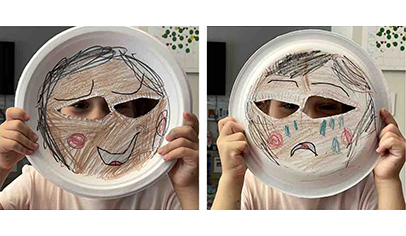How Words Make People Feel

Subject areas: Language Arts, Visual Art, Drama, Social-Emotional Learning
Time commitment: 60 – 90 minutes
Best for: Grades PreK-2

Activity synopsis:
Students create and use two-sided masks to explore how their words and those of others make people feel. They dramatize various interactions to see the impact of words and tone of voice. This project integrates visual art and drama to build social and emotional learning.
Materials list:
- Paper Plates
- Blunt-Tip Scissors
- Washable Markers
- Crayons
- Optional—recycled materials to glue to masks such as construction paper, ribbon, or fabric
Step-by-Step Instructions
RESPOND
Everyone wants to belong—to be seen, heard, and know that others are like them. But sometimes children forget how their words can make others feel. Words can make people shine with happiness. Other words can hurt. Naming them and saying how you feel is part of developing emotional health.
- Discuss emotions. Have children start by talking about feelings that are positive, “what makes you feel proud or appreciated, such as pleasant, cheerful, and friendly?” Then talk about words that are negative. “What words make you feel lonely, disappointed, or frustrated, such as bossy, mean, or annoying?”
- Invite children to sketch faces that show different emotions by changing facial features. Notice how eyebrows and mouths change shape to show how someone is feeling.
CREATE
- Have children create two-sided masks with cut out eyes. On one side they will draw a face that looks proud and appreciated. On the other side they will draw a face that looks lonely, frustrated, or misunderstood. They can add hair and facial detail to the masks.
PRESENT
- Let the drama begin! Have children use their two-sided masks to act out how others’ words make them feel. They will take turns saying different comments such as “You’re bossy!” And “You’re so friendly!” using different tones of voice to see how friends react by turning their masks to the positive or negative sides. Practice in several situations. How do people feel when there is a conflict in the play yard? Or when there is disagreement during a classroom conversation? Every situation can be handled in a positive way when kind words and voices are used.
CONNECT
- Have children keep the masks nearby and use them throughout the day to see how others feel and to show how they feel when others speak to and about them. When we consider how words affect emotions we become more mindful of how we talk to and about others.
Learn more
- Emojis are a great way to see how eyes, eyebrows, and mouth shapes give great clues to emotions. As children look at them and name the feelings shown they build a greater range of emotional responses and vocabulary.
- Build a vocabulary of feeling words from very happy to very upset to describe different emotions. Create a large rainbow with happy at one end and upset at the other and okay at the top. Fill in words along the path of the rainbow using sticky notes or index cards. As children use feeling words in their emotion masks add them to this chart.
- Create short improvised or written scenes about situations that occur at school, home, or in the community. Practice social and emotional learning skits and perform for others.
- Use this activity for a family engagement event, with family members making masks and exploring emotions language to tell how each person feels.
- Explore books about emotion from the library, including The Feelings Book, by Todd Parr; How are you Peeling? by Saxton Fraymann; My Many-Colored Days, by Dr. Seuss; and many others.
- Over the course of human history, masks have been used to represent characters and feelings, to frighten scary things away, and to cover up real feelings. Consider using masks to try on characters in a story, to become someone else and take on other characteristics, or to enter a new and different world.
Crayola offers lessons, projects, webinars, and other art integration ideas at https://www.crayola.com/education



